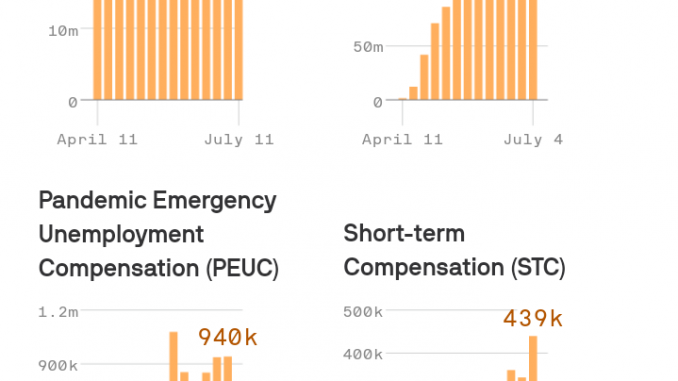
In the first week of July, nearly 1.5 million Americans were receiving unemployment benefits from the little-known Pandemic Emergency Unemployment Compensation and Short-Term Compensation programs.
The state of play: For the week ending April 11, the first week for which data on the programs is available, PEUC and STC programs counted a little over 62,000 and 27,000 claimants each, respectively. That means both programs have seen approximately 15-fold increases in about three months’ time.
- Why it matters: As first-time claims for traditional unemployment benefits have held steady between 1 million and 1.5 million a week for 18 straight weeks, pandemic-specific unemployment insurance programs are spiking, showing greater job losses and weakness in the economy.
What it means: The PEUC program provides additional benefits for those affected by the pandemic who have exhausted traditional state unemployment benefits.
- STC provides benefits to people who still have jobs but whose employers have reduced their hours significantly to avoid layoffs, providing a pro-rata share of weekly benefits based on the reduction in hours of work.
Between the lines: The continuous increase in PEUC claims likely means Americans are staying unemployed for longer and the consistent uptick in STC claims shows that even businesses that have not laid off employees yet have been cutting their hours and having the government pick up the slack.
- The number of people receiving benefits under each newly created program is higher than the total number of people receiving unemployment benefits during any week in 2019.
The big picture: Such programs have helped uphold American consumers’ spending, but have been quite costly — government spending in June totaled $1.1 trillion, according to CBO estimates — more than triple outlays in June 2019, or about a $763 billion increase.
What’s next: The unemployment picture looks to be worsening right as the $600 in additional federal unemployment assistance expires.
- According to the Census Bureau’s weekly Household Pulse Survey published Wednesday, the number of employed Americans declined by about 6.7 million from mid-June through mid-July, including a 4.1 million fall from the first to the second week of July.
- Yelp reported that its tally of business closures that had been declining consistently since March has stalled out with temporary business closures now turning to permanent ones.
- Yelp noted that permanent closures now account for 55% of all closed businesses since March 1, an increase of 14% from June.
*story by Axios